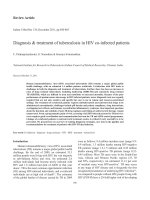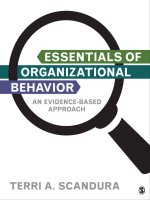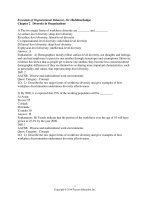Diagnosis treatment of dysfunctional behavior
Bạn đang xem bản rút gọn của tài liệu. Xem và tải ngay bản đầy đủ của tài liệu tại đây (2.21 MB, 113 trang )
Diagnosis & Treatment of dysfunctional Behavior
Overview of Today’s Class
Class #1
Introductions
Review of Syllabus, Assignments, & Course Outline
Brief Review of Historical Influences of DSM-5
Brain Neuroanatomy: Cognitive, Behavioral, & Emotional Functioning
Neuropsychopharmacology: Review of Major Neurotransmitters
Introduction to DSM-5
Introductions!
S
r
e
1
2
3
e
i
s
Review of Syllabus, Assignments, Course Outline
Textbook for the Class:
DSM-5 (yes you need this)
Recommended Supplemental Texts:
DSM-5 Made Easy
DSM-5 Essentials
How to Contact Me:
EMAIL is preferred
Do not use your personal email
972-279-6511 ext. 149
Office Hours by Request (office G)
Private Practice Phone:
719-433-4388
PLEASE DO NOT TEXT ME
USE THIS FOR EMERGENCY’S ONLY
Review of Syllabus, Assignments, Course Outline
Assignments
Attendance/Participation
10% of Final Grade
Each Absence = 1 point off final grade
Mid-Term (10/15/2014)
25% of Final Grade
50 multiple choice questions
Closed Book
Will be given 75 MC Q’s of which 50 will be on the mid-term: 2 weeks in
advance
Final-Exam (11/19/2014)
50% of Final Grade
100 multiple choice questions
Will be composed of 50 questions from mid-term and 50 new questions
Will be given 50 new MC Q’s: 2 weeks in advance
Research Paper:
See syllabus for criteria
15% of final grade
Historical Conceptions of Abnormal Behavior
Normal vs. Abnormal Behavior
Culturally Defined & Dynamic
Philosophical, Theological, Scientific, and
Political Influences
Early Theories of Abnormal Behavior
Supernatural Theories
Demons, Spirits, Moon, Stars, etc.
Dualistic Views
Body/Brain does not equal Soul/Spirit
Descarte
Ancient Greece – soul or “psyche”
Brain was a radiator to cool blood
Psychological Theories
Freud, Adler, Jung, Skinner, Beck,
Maslow, Yalom Etc.
Four Major Schools of Thought:
Psychoanalytic, cognitivist, behaviorist,
humanistic-existential
Many “sub”-movements are
derivatives
Explain the “mind” portion of why
abnormal behavior exists
Biological Theories
Medical model of abnormal behavior
Disruption in physical body/brain
causes aberrant cognition, emotions,
or behavior
American Psychiatric Association
Behavioral Neurology
The Central Nervous System:
Brain Anatomy & Psych Functions
Four Lobes of the Brain
Cortex = outside of brain/gray matter
Sub-Cortex = inside of brain/white matter
Neo-Cortex = prefrontal area
Limbic Region or “lobe”
Bottom-Up Processing
Inside the brain
Basic Life Support = Brain Stem
Primitive Drives = Mid-Brain
Emotions = Limbic Region
Reasoning/Thinking = Cortex
Top-Down Processing
Cortex & Neocortex can inhibit / control primitive behaviors and
reactions
The Central Nervous System:
Brain Anatomy & Psych Functions
Neuropsychological Functions
Attention/Alertness
Processing Speed
Working Memory
Memory
Language
Executive Functions
Visuospatial Processing
Sensorimotor Functioning
Emotional/Personality Functions
The Central Nervous System:
Brain Anatomy & Psych Functions
Brain Stem + Frontal
Motor Cortex
Controls Complex Motor Movements
Prefrontal Area
Attention/Alertness/Arousal
Judgment, Abstract Reasoning, Planning, Initiation, Self-Monitoring,
Social Judgment, Emotional Regulation, Impulse Control, “Outside
the box” thinking
Orbito-Prefrontal Area
Connects with amygdala and regulates fight or flight response
Also implicated with reward/punishment response
The Central Nervous System:
Brain Anatomy & Psych Functions
Temporal Lobe
Left = Verbal Memory
Right = Visual Memory
Memory for Faces, Words, Language
Left Temporal-Parietal Junction
Reading, Math
Also connected to amygdala and hippocampus
Hippocampus
Auditory Processing of Sounds
Consolidates memories
Amygdala
Processing incoming emotional stimuli for fight or flight
response
H – P – A axis
The Central Nervous System:
Brain Anatomy & Psych Functions
Parietal Lobe
Spatial Processing
Navigation
Sensory Perception
Memory for “where”
Spatial Attention
Occipital Lobe
Visual Processing
Visual awareness
Processes visual input of movement, direction, space
The Central Nervous System:
Brain Anatomy & Psych Functions
Limbic System
Processes Emotional Stimuli
Cingulate Gyrus
Anterior (front) = motivation/drive
Hypothalamus
Thirst, Hunger, Sex Drive
Mammillary Bodies
Emotional Memories
Amygdala
Fight or Flight Response
Hippocampus
Consolidates Memory/Learning
Limbic system is considered the “primitive” area of the brain dealing with
emotional drives, social attachment, and learned emotional responses to
triggers
Develops early as an infant but neocortex develops later (i.e., the
regulation of emotions come later)
The Central Nervous System:
Brain Anatomy & Psych Functions
Key Brain Areas Related to Psychiatric Illness:
Basal Ganglia/Amygdala
Basal Forebrain
OCD, Anxiety, Compulsive Behaviors, Parkinson’s, Depression, Schizophrenia
Episodic Memory – Alzheimer’s etc.
Pre-Frontal Areas
Personality, Impulse Control, Reward
Amygdala
Hippocampus
Nucleus Accumbens
Addictions
Left Hemisphere damage = depression
Right Hemisphere damage = mania
Thalamus, Corpus Callosum
Temporal Lobes (especially left)
Seizures, Schizophrenia
Neuropsychopharmacology: The Basics
Neurotransmitters
Chemical messengers of neurons
Can be excitatory, inhibitory, or modulatory
In other words, neurotransmitters can progress a message,
stop a message, or modify a message
Neuropsychopharmacology: The Basics
Dopamine
Implicated with schizophrenia (too much dopamine), ADHD (too
little), depression (too little), and Parkinson’s (too little)
Substantia Nigra & Ventral Tegmental
Dopamine Antagonist = Antipsychotic medication
Basal ganglia projects to frontal/pre-frontal
Serotonin
pain modulation, OCD, PTSD, GAD, social phobia, attachment
Risperdal, Geodon, Clozaril, Seroquel
disorders, eating disorders, and aggression
Agonist = ADHD, depression meds
Adderall, Vyvanse, Wellbutrin, MAOI Inhibitors, Ritalin
Implicated with depression, anxiety, sleep problems, weight loss,
Raphe nuclei
projects to limbic regions, basal ganglia, prefrontal, hypothalamus, brain stem
Agonist
SSRIs (e.g., Prozac, Effexor, Celexa,)
Tricyclics (e.g., amitriptyline)
Neuropsychopharmacology: The Basics
Acetylcholine
Implicated with memory, attention, and cognitive disorders
Basal Forebrain
Projects to thalamus, cortex, hippocampus
Antagonists = antihistamines, first generation antipsychotics,
tricyclic antidepressants
Agonists = acetylcholinesterase inhibitor (e.g., Aricept)
Supposedly improves memory/cognition in dementia and TBI
Not to be confused with ACE-Inhibitors
Norepinephrine
Locus coeruleus
Implicated with attention disorders, pain modulation, bipolar
disorder, anxiety, OCD, and depression
Projects to entire cerebral cortex
Agonists = methylphenidate, Concerta, Strattera, Provigil
Antagonists = cholinergic and serotonergic agonists
Neuropsychopharmacology: The Basics
Gamma-aminobutryic acid (GABA)
Implicated with anxiety disorders (too little), panic disorders (too
little), seizures (too little), and memory disorders (too much)
Found throughout the cerebral cortex and limbic system
Agonists = Valium, Xanax, Ativan
Can have a negative effect on memory
Can cause “drunk-like” symptoms
Highly addictive
Glutamate
Implicated with neurodegenerative diseases such as Alzheimer’s
Widely distributed throughout brain
Agonists = NMDA receptor antagonists such as Namenda
Implicated with learning, memory, and neurogenesis/synaptic
plasticity
Neuropsychopharmacology: The Basics
Classes of Psychotropic Medications:
Antidepressants
Psychostimulants
Dopamine & Norepinephrine Agonists
Anticonvulsants/Mood Stabilizers
Bipolar Meds, Lithium, Seizure Meds
Antipsychotics
SSRIs, SNRIs, Tricyclics, MAOI Inhibitors
1st/2nd Generation, Atypical
Anxiolytics
GABA agonists
Cognitive-enhancing (nootropics)
Aricept, Namenda
DSM-5: Basic Overview
Changes from DSM-IV-TR include:
No more 5-axis diagnosis
Improved attempt at non-overlapping criteria
Integration of neuroscience research
Consolidated autism spectrum disorders
Improved classification of:
Bipolar, Depression, Mood disorders
Addition of Neurocognitive Disorders
Pro’s:
New research, better classifications
Enhanced clinical utility with ICD-10
Includes neurocognitive disorders
Con’s:
Same old personality stuff
Criteria “too sensitive”
Potentially causing over-medicating
Questionable Validity of Diagnostic Criteria
Where exactly is the research?
Complicated criteria for PTSD and other diagnoses
DSM-5: Basic Overview
DSM-5 Divided Into Diagnostic Categories:
Neurodevelopmental disorders
Schizophrenia Spectrum and other Psychotic Disorders
Bipolar and Related Disorders
Depressive disorders
Anxiety disorders
OC and Related disorders
Trauma/Stressor-Related disorders
Dissociative disorders
Somatic symptom and related disorders
Feeding and eating disorders
Elimination disorders
Sleep-wake disorders
Sexual dysfunctions
Gender dysphoria
Disruptive, impulse control, Conduct
Substance-related and addiction
Neurocognitive disorders
Personality disorders
Paraphilic disorders
Etc., etc., etc.,
Don’t you fret! We will review all of these in detail in this class!
Dysfunctional Behavior
Class # 2
Overview for Tonight:
Research Paper Review
APA Formatting
Basic Requirements
Brief Review of Last Class
Brain Functions, Neurotransmitters
Diagnostic Interviewing
Introduction #1 of 2 reviews
DSM-5
Neurodevelopmental Disorders
Brief Historical Review
Diagnostic Criteria
Brain Implications
Treatment
Research Paper Review
Tips from the Trenches:
Read the APA formatting manual
Review OWL’s website for help
/>1
/
You are writing a “review” or “article critique”
See example of paper on FTP site
Write as though you are a reporter for a
newspaper (without bias)
Tips from the Trenches Continued:
Brief Introduction (no heading)
Should have the following headings (level 1):
Historical Data (MANDATORY)
Diagnostic Criteria (MANDATORY)
Differential Diagnoses (MANDATORY)
Include medical conditions that can mimic disorder
Neuroanatomical Correlates of Disorder (OPTIONAL)
Recommended Treatment (MANDATORY)
Counseling Interventions
Common medications used to treat disorder
Ethical/Legal Concerns (MANDATORY)
Critique of DSM-5 Diagnostic Criteria (MANDATORY)
Future Research Recommendations (OPTIONAL)
BRAIN BREAK
Diagnostic Interviewing
Lecture 1 of 2
What is a diagnostic interview?
Usually performed during initial meeting with client
Sometimes takes a few sessions (2 or 3 at most)
Reviews a wide range of the client’s history and symptoms
See next slide
Purpose is to establish a provisional diagnosis so as to delineate a specific plan for treatment
Identifies other conditions in need of a referral to ancillary providers
Should be therapeutic in nature and an effective means for “breaking the ice” during initial sessions with the client
Often erroneously overlooked when practicing counseling
Can be performed with individuals, couples, and families
Diagnostic Interviewing
Lecture 1 of 2
Review of the Client’s Chief Complaint/Main Areas of Concern
Chief Complaint
Client’s spontaneous list of concerns
WHY SEEK THERAPY NOW?
When did the symptoms begin?
How often do they occur?
What is the severity of the symptoms?
In what context do the symptoms occur? Triggers, etc.?
What, if anything, helps decrease or manage the symptoms?
QUICK TIP: Most, if not all this information, can be gathered with an intake questionnaire to be reviewed by you in
the first session.









